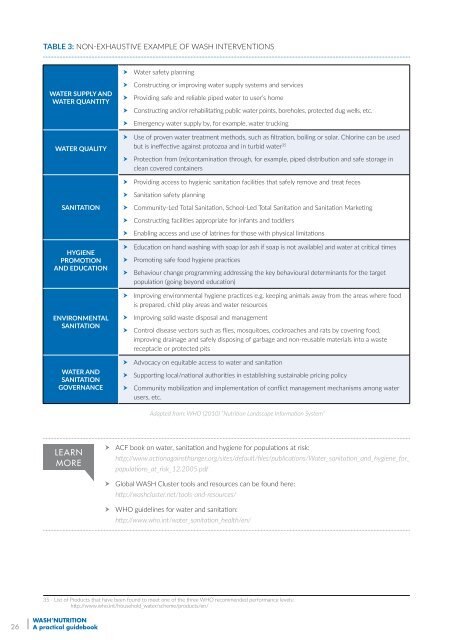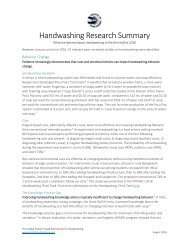WASH’ Nutrition
manuel_wash_nutrition_online
manuel_wash_nutrition_online
You also want an ePaper? Increase the reach of your titles
YUMPU automatically turns print PDFs into web optimized ePapers that Google loves.
Table 3: Non-exhaustive example of WASH interventions<br />
Water safety planning<br />
WATER SUPPLY AND<br />
WATER QUANTITY<br />
Constructing or improving water supply systems and services<br />
Providing safe and reliable piped water to user’s home<br />
Constructing and/or rehabilitating public water points, boreholes, protected dug wells, etc.<br />
Emergency water supply by, for example, water trucking<br />
WATER QUALITY<br />
Use of proven water treatment methods, such as filtration, boiling or solar. Chlorine can be used<br />
but is ineffective against protozoa and in turbid water 35<br />
Protection from (re)contamination through, for example, piped distribution and safe storage in<br />
clean covered containers<br />
Providing access to hygienic sanitation facilities that safely remove and treat feces<br />
Sanitation safety planning<br />
SANITATION<br />
Community-Led Total Sanitation, School-Led Total Sanitation and Sanitation Marketing<br />
Constructing facilities appropriate for infants and toddlers<br />
Enabling access and use of latrines for those with physical limitations<br />
HYGIENE<br />
PROMOTION<br />
AND EDUCATION<br />
Education on hand washing with soap (or ash if soap is not available) and water at critical times<br />
Promoting safe food hygiene practices<br />
Behaviour change programming addressing the key behavioural determinants for the target<br />
population (going beyond education)<br />
Improving environmental hygiene practices e.g. keeping animals away from the areas where food<br />
is prepared, child play areas and water resources<br />
ENVIRONMENTAL<br />
SANITATION<br />
WATER AND<br />
SANITATION<br />
GOVERNANCE<br />
Improving solid waste disposal and management<br />
Control disease vectors such as flies, mosquitoes, cockroaches and rats by covering food,<br />
improving drainage and safely disposing of garbage and non-reusable materials into a waste<br />
receptacle or protected pits<br />
Advocacy on equitable access to water and sanitation<br />
Supporting local/national authorities in establishing sustainable pricing policy<br />
Community mobilization and implementation of conflict management mechanisms among water<br />
users, etc.<br />
Adapted from: WHO (2010) “<strong>Nutrition</strong> Landscape Information System”<br />
LEARN<br />
MORE<br />
ACF book on water, sanitation and hygiene for populations at risk:<br />
http://www.actionagainsthunger.org/sites/default/files/publications/Water_sanitation_and_hygiene_for_<br />
populations_at_risk_12.2005.pdf<br />
Global WASH Cluster tools and resources can be found here:<br />
http://washcluster.net/tools-and-resources/<br />
WHO guidelines for water and sanitation:<br />
http://www.who.int/water_sanitation_health/en/<br />
35 - List of Products that have been found to meet one of the three WHO recommended performance levels:<br />
http://www.who.int/household_water/scheme/products/en/<br />
26<br />
<strong>WASH’</strong><strong>Nutrition</strong><br />
A practical guidebook



